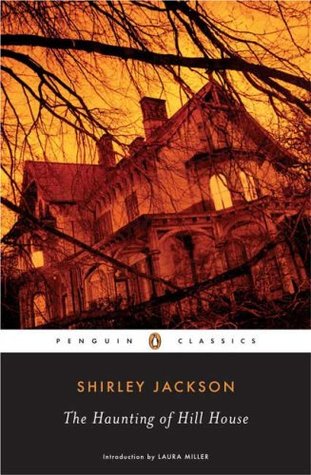The Haunting of Hill House
She turned her car onto the last stretch of straight drive leading her directly, face to face, to Hill House and, moving without thought, pressed her foot on the brake to stall the car and sat, staring. The house was vile. She shivered and thought, the words coming freely into her mind, Hill House is vile, it is diseased; get away from here at once.
Oh, Eleanor – if only you had listened to your intuition. As a Halloween read, The Haunting of Hill House was a satisfying choice – rich in psychological horror, and ultimately, more psychological than horrific. This is a truly literary ghost story that captures the uneasy vibe of the Cold War Fifties – duck-and-cover works about as well against midnight visions as it would against The Bomb – and author Shirley Jackson proves that the scariest hauntings are those that are created within our own minds. Mild spoilers beyond – this is a sixty year old story.
This house, which seemed somehow to have formed itself, flying together into its own powerful pattern under the hands of its builders, fitting itself into its own construction of lines and angles, reared its great head back against the sky without concession to humanity. It was a house without kindness, never meant to be lived in, not a fit place for people or for love or for hope. Exorcism cannot alter the countenance of a house; Hill House would stay as it was until it was destroyed.
The Haunting of Hill House is the story of an experiment: Dr. John Montague, interested in putting a purported haunted house under strict scientific observation, has rented the creepy Hill House and sent out invitations to experts of several disciplines to join him there. Unfortunately, only two of those he has invited have agreed to join him at Hill House – Theodora, a vivacious young woman of proven psychic ability, and Eleanor, a downtrodden introvert who once experienced poltergeist phenomena – and joining this less-than-ideal scientific crew is Luke – the bon vivant future heir of Hill House, sent along at his family's insistence. From their first meeting, Eleanor is enchanted with the free-spirited Theodora, and as the foursome gather in the parlour on the first night, Eleanor is delighted by the quick-witted repartee and bonhomie of her fellows; having spent her thirty-two years caring for her sick and demanding mother, Eleanor has never before had a friend (or even a private conversation with a young man), and despite her downplaying her experience with the supernatural, Eleanor feels a belonging she had never before known. When things do start to go bump in the night, Eleanor is almost more grateful to have Theodora by her side than she is scared by the noises. Yet, being so beaten-down, Eleanor often doubts the friendship – thinking Theo is attention-seeking; worried that Theo and Luke are making fun of her in private rendezvous – and as there are no eyewitnesses to anything eerie that happens, it's unclear what is real and what is manufactured.
Now we are going to have a new noise, Eleanor thought, listening to the inside of her head; it is changing. The pounding had stopped, as though it had proved ineffectual, and there was now a swift movement up and down the hall, as of an animal pacing back and forth with unbelievable impatience, watching first one door and then another, alert for a movement inside, and there was again the little babbling murmur which Eleanor remembered; Am I doing it? She wondered quickly, is that me? And heard the tiny laughter beyond the door, mocking her.
In the opening sequence, when Eleanor is driving through the countryside towards Hill House, we read her thoughts as she fantasises about living in the little cottages she sees along the way. As she reveals her history to the rest of the group, we recognise when she is fibbing – substituting the recent fantasy for her sad reality – but eventually, we have to wonder if Eleanor herself truly knows the difference. Her thinking becomes so muddled, and her paranoia about reality so crippling, that it's a very different Eleanor whose thoughts we read near the end:
Under her feet the stone floor moved caressingly, rubbing itself against the soles of her feet, and all around the soft air touched her, stirring her hair, drifting against her fingers, coming in a light breath across her mouth, and she danced in circles. No stone lions for me, she thought, no oleanders; I have broken the spell of Hill House and somehow come inside. I am home, she thought, and stopped in wonder at the thought. I am home, I am home, she thought; now to climb.
Hill House feels foreboding, yet there's nothing concrete written about its appearance beyond dark rooms, a confusing floor plan, and uneven floors and walls apparently meant to disorient the mind; this non-description makes for a feeling of unspecified dread; the best kind of dread. There are some quite scary scenes (God God – whose hand was I holding?), and as the foursome often engage in verbal jousting, there's quite a bit that's funny, too – everything about the dour housekeeper Mrs. Dudley made me smile. At the beginning, The Haunting of Hill House feels like a scientific exploration of paranormal phenomena, but through the slow unspooling of Eleanor's story, it is eventually revealed to be a psychological study of an unstable mind – and that's what makes this a special kind of book; you might not jump, but you'll end with something to think on. I hope wherever Eleanor ended up, she found her cup of stars.

